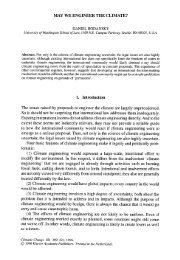ThorEA - Towards an Alternative Nuclear Future.pdf
ThorEA - Towards an Alternative Nuclear Future.pdf
ThorEA - Towards an Alternative Nuclear Future.pdf
You also want an ePaper? Increase the reach of your titles
YUMPU automatically turns print PDFs into web optimized ePapers that Google loves.
Chapter 1: Thorium-fuelled ADSRs <strong>an</strong>d their potential UK <strong>an</strong>d global impact continued<br />
It should be noted that export sales would form a signific<strong>an</strong>t<br />
component of <strong>an</strong>y commercial proposition. However, in the<br />
Potential Exp<strong>an</strong>sion scenario, export to non-OECD nations<br />
will predominate, yet the export of conventional nuclear<br />
power is expected to be limited to those countries with<br />
minimal proliferation risks, well established nuclear power<br />
infrastructure <strong>an</strong>d tight security.<br />
There is <strong>an</strong> additional requirement for the technology offered<br />
to developing countries to be of the appropriate scale; too<br />
small <strong>an</strong>d the contribution to the electricity dem<strong>an</strong>d is too<br />
little to justify the investment of effort <strong>an</strong>d money; too large<br />
<strong>an</strong>d the stability of the existing grid is threatened.<br />
Thorium-fuelled ADSRs, when configured appropriately,<br />
overcome these issues. The proliferation resist<strong>an</strong>ce <strong>an</strong>d safe<br />
sub-critical operation of these systems signific<strong>an</strong>tly increases<br />
the number of countries to which export is possible. The<br />
600MWe ADSR used as <strong>an</strong> illustration above is <strong>an</strong> entirely<br />
realistic proposition for export to <strong>an</strong>d deployment in both fully<br />
industrialised nations, <strong>an</strong>d those with weaker infrastructure.<br />
Moreover, a detailed cost <strong>an</strong>alysis indicates that the lifetime<br />
costs of a thorium fuelled ADSR reactor for power generation<br />
would be comparable to those of conventional power systems<br />
(Appendix VIII).<br />
During the 1980s a new nuclear power station came on line<br />
every 17 days. Over the next three decades dem<strong>an</strong>d will be<br />
considerably higher. It is precisely this dem<strong>an</strong>d into which<br />
a thorium-fuelled ADSR industry would tap.<br />
1.6 The consequences of the UK seizing global<br />
leadership in thorium-fuelled ADSR technology<br />
Should the UK choose now to develop global leadership<br />
in thorium-fuelled ADSR technology, a not unimaginable<br />
scenario for the year 2040 could be as follows:<br />
A rejuvenated nuclear industry is generating 40% of UK<br />
electricity. This contribution, combined with renewables <strong>an</strong>d<br />
consumption reduction efforts have, much to the surprise of<br />
m<strong>an</strong>y, enabled CO2 reduction targets to be hit. This has given the<br />
UK considerable credibility at the international climate ch<strong>an</strong>ge<br />
negotiating table, where it is pressing for tougher targets.<br />
16 <strong>Towards</strong> <strong>an</strong> <strong>Alternative</strong> <strong>Nuclear</strong> <strong>Future</strong><br />
While there are obvious environmental benefits of deeper cuts<br />
in CO2, Britain has a further incentive: as the world leader in the<br />
thorium-fuelled ADSR industry – the safest, most proliferationresist<strong>an</strong>t,<br />
waste-minimising nuclear power technology – further<br />
cuts equate to larger markets for IP, technology know-how, <strong>an</strong>d<br />
services. From the successful development of reliable off-theshelf<br />
10MW accelerators <strong>an</strong>d other related technologies in the<br />
period 2010-2020 the UK has been able to build a signific<strong>an</strong>t<br />
ADSR industry. The technical expertise, m<strong>an</strong>ufacturing,<br />
licensing of IP <strong>an</strong>d support industries are contributing to GDP<br />
growth <strong>an</strong>d generating £multi-bn export revenue p.a. for UK<br />
plc. Over 30,000 people are directly employed in the industry.<br />
The growth in cle<strong>an</strong> indigenous power generation has facilitated<br />
the shift to electric vehicles resulting in a dramatic improvement<br />
in urb<strong>an</strong> air quality <strong>an</strong>d traffic noise. Spin-offs from the<br />
development of various related technologies have enabled<br />
further exploitation of IP, both in the UK <strong>an</strong>d overseas. Imports of<br />
oil <strong>an</strong>d gas have fallen – the ‘repatriation of the power pound’ as<br />
the Daily Mail likes to refer to it.<br />
The growth of the UK’s nuclear industry has also contributed to<br />
the re-vitalisation of regional economies. The NW has benefited<br />
from the research <strong>an</strong>d development efforts of the previous<br />
thirty years. The Sellafield site has consolidated its position<br />
as a global centre of excellence for re-processing.<br />
British industry <strong>an</strong>d consumers are protected from the worst<br />
fluctuations in oil <strong>an</strong>d gas prices, <strong>an</strong>d are insulated to some<br />
degree from the ever-increasing price of carbon. A further bonus<br />
is that UK business benefits from lower energy prices making it<br />
more competitive in the global marketplace.<br />
Thorium-fuelled ADSRs have become for m<strong>an</strong>y ‘the acceptable<br />
face of nuclear’.<br />
The question is not whether<br />
the UK c<strong>an</strong> afford to invest<br />
in thorium-fuelled ADSR<br />
technology, but whether it<br />
c<strong>an</strong> afford not to.



